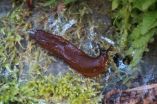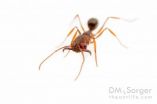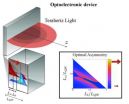(Press-News.org) Frankfurt am Main, Germany, June 18th 2014. Spanish slugs (Arion lusitanicus) are one of the most common slug species in Central Europe. The animals sometimes nicknamed "killer slugs" are known to do their fair share of damage in fields and gardens. The slug was thought to have originated in Southern Europe. However researchers of the German Biodiversity and Climate Centre and the Goethe University now found out, that the prime example of an invasive species is originally from Central Europe and thus no "immigrant" after all. Control measures, such as the EU regulation on prevention, early warning, rapid response, and management of invasive species which is being discussed currently, would therefore not apply to this species. Spanish slugs (Arion lusitanicus) are one of the most common slug species in Central Europe. The animals sometimes nicknamed "killer slugs" are known to do their fair share of damage in fields and gardens. The slug was thought to have originated in Southern Europe. However researchers of the German Biodiversity and Climate Centre and the Goethe University now found out, that the prime example of an invasive species is originally from Central Europe and thus no "immigrant" after all. Control measures, such as the EU regulation on prevention, early warning, rapid response, and management of invasive species which is being discussed currently, would therefore not apply to this species.
For some time conservationists have made aware of the fact that the rapidly growing number of brown Spanish slugs is replacing the native black slug in Central Europe as well as inflicting significant damage on natural vegetation and agricultural products. The numbers speak for themselves: today Arion lusitanicus is the most common species of snail in Germany. It is also ranked among the "100 of the worst" invasive animal and plant species in Central Europe that are thought to have a significant negative impact on biodiversity, economy and health. Allegedly the Spanish Slug made its way to Central Europe with imports of fruit and vegetables in the 1950s.
No Spanish slugs to be found in Spain
When taking stock German researchers however could not find a single individual of the slug in its presumed home country. In the spring of 2010 researchers of the Biodiversity and Climate Research Centre and the Goethe University collected 300 specimens of the snail in 60 locations in France, Spain, the UK and the Benelux countries and identified the species they came from. "Instead of the Spanish slug we found numerous, so-called cryptic species, which are indistinguishable using traditional methods of taxonomy which is based on morphology. Therefore, the animals were identified using DNA sequence data" lead author Prof. Markus Pfenninger, who conducts research on BiK-F and the Goethe University and teaches, explains.
Many cryptic species
Many of the specimens examined did not fit to a previously described, genetically characterized species. "We found a lot of unnamed, sometimes highly divergent haplotypes. This indicates the presence of several undescribed Arion species which we only discover using DNA taxonomy. It follows that Arion is very unresolved genus from a taxonomic point of view." But looking into the genes of the slugs yielded even more insights. Shared mutations in the genetic information of different individuals indicate relationships between them. "On the basis of this we created a phylogenetic tree and related it to the geographic distribution. It showed why we could not find Arion lusitanicus in its alleged homeland. The species is definitely not native to Spain but originated in Central Europe" concludes Pfenninger.
EU-regulations on alien species would not necessarily apply
According to experts there are more than 12,000 non-native species in Europe, and the number is increasing. Alien species are one of the main threats to biodiversity and native species as well as causing immense economic damage, e.g. via yield losses in agriculture. In April 2014 the EU parliament therefore approved a proposal for EU-wide measures to ban further import of non-native species and combatting non-native species which are already at home in EU more effectively. "Whether a species is classified as native or not will influence its management policy. Our research goes to show that we should be more prudent in labeling a species 'invasive' or non-native when the evidence for anthropogenic introduction is poor", says Pfenninger and adds: "Perhaps the rapid increase in Spanish slugs we have seen in the last decades is caused by changes of land use practice. It may seem like an invasion when in truth there isn't one going on ".
INFORMATION:
Spanish slug -- Busting an invasion myth
Species is originally from Central Europe
2014-06-18
ELSE PRESS RELEASES FROM THIS DATE:
New study is first to identify, clarify MERS-related abnormality distribution on CT
2014-06-18
Leesburg, VA, June 18, 2014—Researchers in Saudi Arabia have identified key defining characteristics of Middle East Respiratory Syndrome (MERS) in CT imaging of patients confirmed as having the disease.
The study found that the most common CT finding in hospitalized patients with MERS infection is suggestive of an organizing pneumonia pattern.
"A few studies have described variable degrees of lung opacities in patients with MERS, but did not clearly address their exact distribution," said Amr M. Ajlan, the corresponding author of the study. "Because we evaluated the ...
Study shows cost-effectiveness of smoking cessation counseling during hospitalization
2014-06-18
OTTAWA, June 18, 2014 – In a recent study published in Tobacco Control, researchers at the University of Ottawa Heart Institute have demonstrated the cost-effectiveness of the Ottawa Model for Smoking Cessation (OMSC), an intervention that includes in-hospital counseling, pharmacotherapy and post-hospital follow-up, compared to usual care among smokers hospitalized with acute myocardial infarction, unstable angina, heart failure, and chronic obstructive pulmonary disease.
The study examined patients hospitalized in Ontario, a province with a population of approximately ...
Animals conceal sickness symptoms in certain social situations
2014-06-18
The review's sole author, Dr. Patricia Lopes from the Institute of Evolutionary Biology and Environmental Studies at the University of Zurich, says that animals from a number of different species will eat and drink less, reduce their activity and sleep more when they are sick in order to conserve energy for their recovery. However, this can all change depending on the social situation.
In a paper published this week in the journal Proceedings of the Royal Society B, Lopes reviewed a range of different social situations that affected the behavior of sick animals, including ...
Childhood maltreatment associated with cerebral grey matter abnormalities
2014-06-18
An international study has analysed the association between childhood maltreatment and the volume of cerebral grey matter, responsible for processing information. The results revealed a significant deficit in various late developing regions of the brain after abuse.
According to the World Health Organisation (WHO), child maltreatment is defined as all forms of physical and/or emotional ill-treatment, sexual abuse, neglect or negligent treatment or commercial or other exploitation, resulting in actual or potential harm to the child's health, survival, development or dignity ...
Trap-jaw ants spreading in southeastern United States
2014-06-18
Trap-jaw ant species are active hunters with venomous stings and jaws powerful enough to fling themselves through the air. According to new research, they are also spreading into new territory in the southeastern United States. The research was done by scientists at North Carolina State University, the Mississippi Entomological Museum, the University of California, Davis and Archbold Biological Station.
"The fact that some of these species are spreading is interesting, in part, because these giant ants have managed to expand their territory without anyone noticing," says ...
Scientists about sequencing data: We drown in data but thirst for knowledge
2014-06-18
While more and more genomic information is becoming available at a drastically increasing pace, the knowledge we can gain about how microorganisms interact with their surrounding, infect hosts and alter their molecular programs in accordance to changing environmental conditions remains widely not deducible from genomic data alone, the researchers from University of Southern Denmark claim. This raises questions regarding the value of newly sequenced species.
The researchers have analyzed the genomes that are available from the past 20 years of sequencing bacterial DNA. ...
Horizontal levitation: The ultimate solution to particle separation
2014-06-18
Magnetic separators exploit the difference in magnetic properties between minerals, for example when separating magnetite from quartz. But this exercise becomes considerably more complex when the particles are not magnetic. In the wake of previous particle levitation experiments under high-power magnetic fields, a new study reveals that particles are deflected away from the magnet's round-shaped bore centre in a horizontal direction. Previous studies had observed the vertical levitation of the particles. These findings are presented by Shixiao Liu from the Faculty of Engineering, ...
New quantum mechanism to trigger the emission of tunable light at terahertz frequencies
2014-06-18
Scientists have found that two-dimensional (2D) nanostructures with asymmetric design enable a new quantum mechanism, triggering the emission of tunable light at terahertz frequencies—with unprecedented efficiency.
The researchers, from the University of Southampton and Imperial College London, found that quantum wells, 2D nanostructures formed of several layers of semi-conductor alloys placed on top of each other like a sandwich, can enhance light emission in a technological challenging spectral range.
It is hoped that the findings will have an impact on photonic ...
Only 16 percent of Ph.D.s work in the private sector in Spain, half the OECD average
2014-06-18
This news release is available in Spanish.
The report explains that Ph.D.s who work as researchers represent, on average in the OECD, 68.6% of those who are employed. By institutional sectors, the percentages of employees who work as researchers break down as follows: 45.4% in the private sector, 70.8% in public administration and 75.9% in higher education. In Spain, 86% of Ph.D.s employed in higher education are researchers, while for the private sector, this figure is only 26.5%.
According to OECD figures, leading innovative countries like the United States, ...
A noisy world: Crabs can hear
2014-06-18
In new research published in the journal Proceedings of the Royal Society B, Northeastern University professor Randall Hughes and her team at the Marine Science Center in Nahant, Mass. are the first to show that sound plays at least as much of a role in mud crabs' reaction to fish behavior as other widely studied cues—and possibly more.
Fish are not silent creatures. Just like the terrestrial world, there's a veritable symphony of sound echoing under the sea. Indeed, the black drum fish was the subject of many a phone call to the Miami police back in 2005, when their ...
LAST 30 PRESS RELEASES:
From novel therapies to first-in-human trials, City of Hope advances blood cancer care at the American Society of Hematology (ASH) annual conference
Research aims to strengthen the security of in-person voting machines
New study exposes hidden Alzheimer’s 'hot spots' in rural Maryland and what they reveal about America’s growing healthcare divide
ASH 2025: Study connects Agent Orange exposure to earlier and more severe cases of myelodysplastic syndrome
ASH 2025: New data highlights promise of pivekimab sunirine in two aggressive blood cancers
IADR elects George Belibasakis as vice-president
Expanding the search for quantum-ready 2D materials
White paper on leadership opportunities for AI to increase employee value released by University of Phoenix College of Doctoral Studies
ASH 2025: New combination approach aims to make CAR T more durable in lymphoma
‘Ready-made’ T-cell gene therapy tackles ‘incurable’ T-cell leukemia
How brain activity changes throughout the day
Australian scientists reveal new genetic risk for severe macular degeneration
GLP-1 receptor agonists likely have little or no effect on obesity-related cancer risk
Precision immunotherapy to improve sepsis outcomes
Insilico Medicine unveils winter edition of Pharma.AI, accelerating the path to pharmaceutical superintelligence
Study finds most people trust doctors more than AI but see its potential for cancer diagnosis
School reopening during COVID-19 pandemic associated with improvement in children’s mental health
Research alert: Old molecules show promise for fighting resistant strains of COVID-19 virus
Journal of Nuclear Medicine Technology supplement highlights advances in theranostics and opportunities for growth
New paper rocks earthquake science with a clever computational trick
ASH 2025: Milder chemo works for rare, aggressive lymphoma
Olfaction written in bones: New insights into the evolution of the sense of smell in mammals
Engineering simulations rewrite the timeline of the evolution of hearing in mammals
New research links health impacts related to 'forever chemicals' to billions in economic losses
Unified EEG imaging improves mapping for epilepsy surgery
$80 million in donations propels UCI MIND toward world-class center focused on dementia
Illinois research uncovers harvest and nutrient strategies to boost bioenergy profits
How did Bronze Age plague spread? A sheep might solve the mystery
Mental health professionals urged to do their own evaluations of AI-based tools
Insufficient sleep associated with decreased life expectancy
[Press-News.org] Spanish slug -- Busting an invasion mythSpecies is originally from Central Europe






